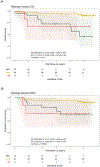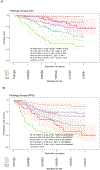Clinicopathologic Characteristics of Mesonephric Adenocarcinomas and Mesonephric-like Adenocarcinomas in the Gynecologic Tract: A Multi-institutional Study
- PMID: 33165093
- PMCID: PMC7954854
- DOI: 10.1097/PAS.0000000000001612
Clinicopathologic Characteristics of Mesonephric Adenocarcinomas and Mesonephric-like Adenocarcinomas in the Gynecologic Tract: A Multi-institutional Study
Abstract
Mesonephric adenocarcinoma (MA) and mesonephric-like adenocarcinoma (MLA) are uncommon neoplasms of the gynecologic tract that have until recently been poorly understood. Although their morphologic, immunohistochemical, and molecular profiles have been recently defined, little is known about their clinical behavior. Small studies have demonstrated inconsistent findings and no large studies have examined the clinical behavior of these adenocarcinomas. In this multi-institutional study, representing the largest and most stringently defined cohort of cases to date, we examined the clinicopathologic features of 99 MAs and MLAs (30 MAs of the uterine cervix, 44 MLAs of the endometrium, and 25 MLAs of the ovary). Only tumors with characteristic mesonephric morphology and either immunohistochemical or molecular support were included. Our results demonstrate that the majority of mesonephric neoplasms presented at an advanced stage (II to IV) (15/25 [60%] MA of the cervix, 25/43 [58%] MLA of the endometrium, and 7/18 [39%] MLA of the ovary). The majority (46/89 [52%] overall, 12/24 [50%] MA of the cervix, 24/41 [59%] MLA of the endometrium, and 10/24 [42%] MLA of the ovary) developed recurrences, most commonly distant (9/12 [75%] MA of the cervix, 22/24 [92%] MLA of the endometrium, and 5/9 [56%] MLA of the ovary). The 5-year disease-specific survival was 74% (n=26) for MA of cervix, 72% (n=43) for MLA of endometrium, and 71% (n=23) for MLA of ovary. Our results confirm that mesonephric neoplasms are a clinically aggressive group of gynecologic carcinomas that typically present at an advanced stage, with a predilection for pulmonary recurrence.
Copyright © 2020 Wolters Kluwer Health, Inc. All rights reserved.
Conflict of interest statement
Conflicts of Interest and Source of Funding: The authors have disclosed that they have no significant relationships with, or financial interest in, any commercial companies pertaining to this article.
Figures




References
-
- McFarland M, Quick CM & McCluggage WG Hormone receptor-negative, thyroid transcription factor 1-positive uterine and ovarian adenocarcinomas: report of a series of mesonephric-like adenocarcinomas. Histopathology. 2016; 68, 1013–1020. - PubMed
-
- Clement PB, Young RH, Keh P et al. Malignant mesonephric neoplasms of the uterine cervix. A report of eight cases, including four with a malignant spindle cell component. Am J Surg Pathol. 1995; 19, 1158–1171. - PubMed
-
- Kolin DL, Costigan DC, Dong F, et al. A Combined Morphologic and Molecular Approach to Retrospectively Identify KRAS-Mutated Mesonephric-like Adenocarcinomas of the Endometrium. Am J Surg Pathol. 2018. - PubMed

